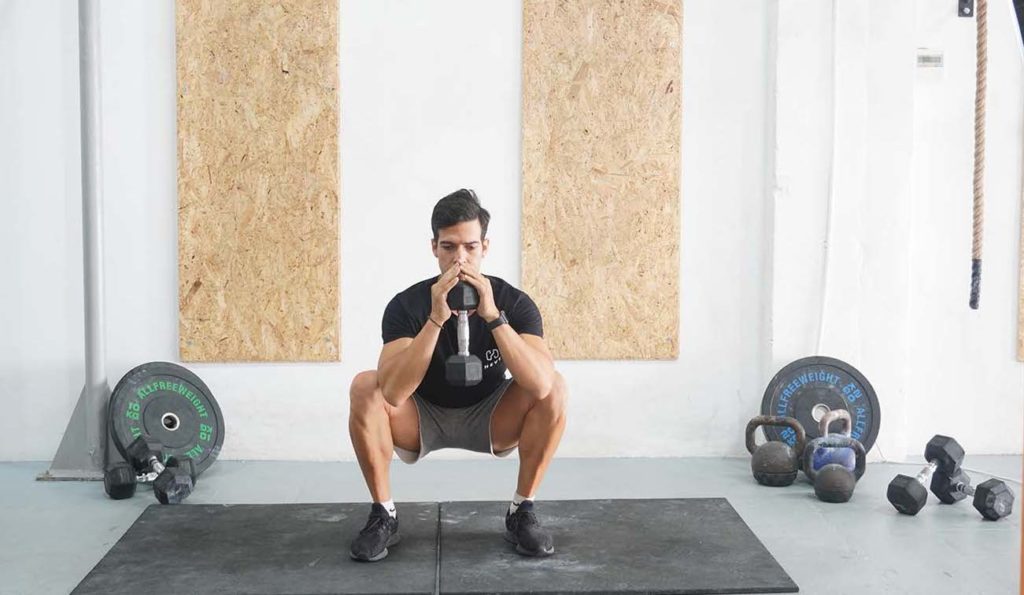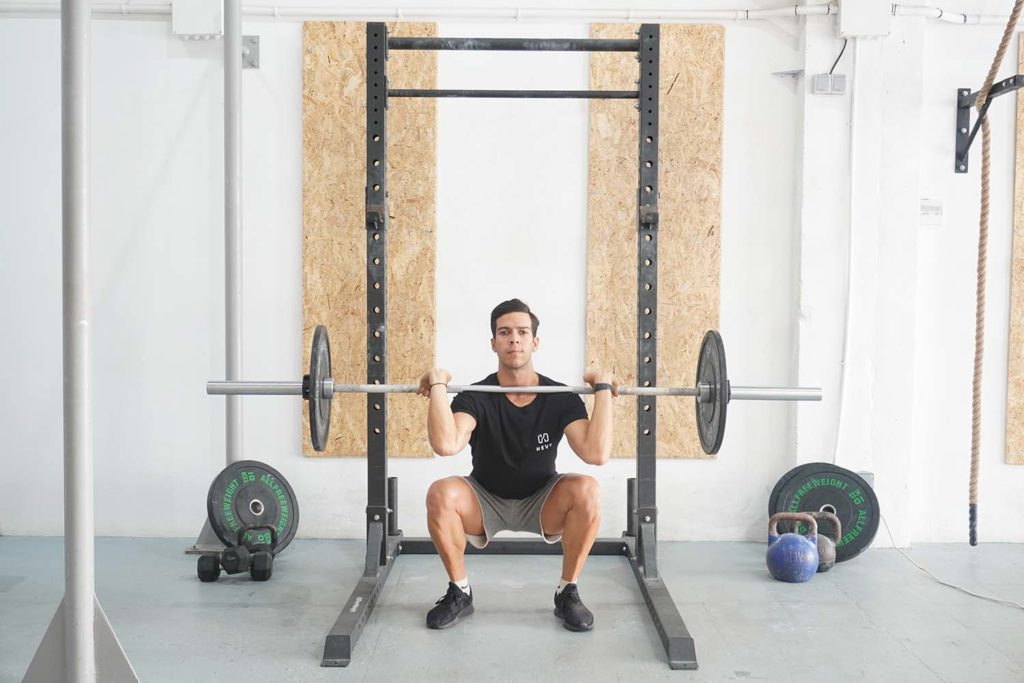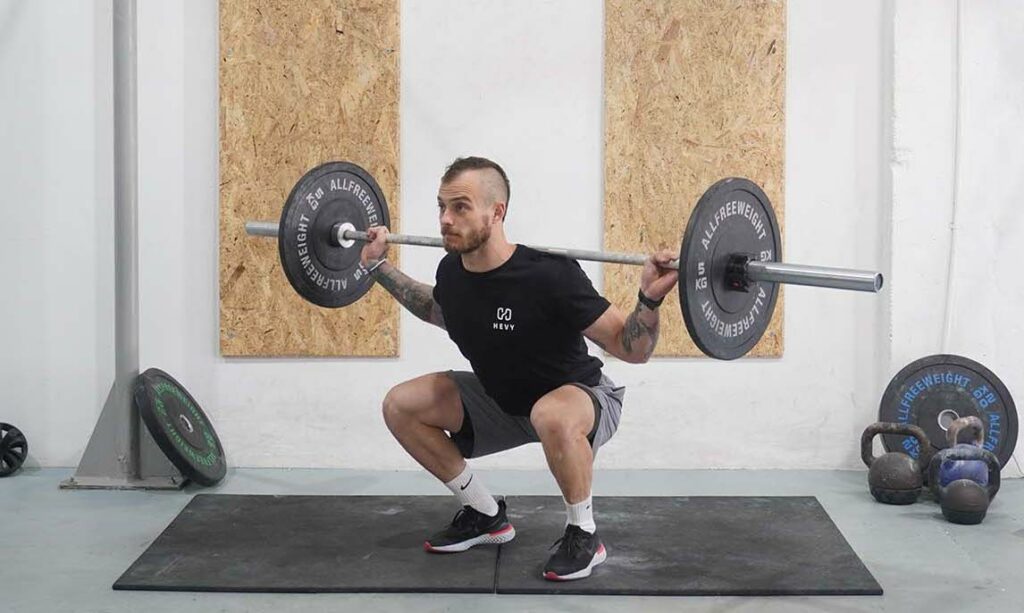Why is it called the sumo squat?
The sumo squat is an effective but often overlooked variation that strengthens the lower body and works our inner thigh muscles. The exercise gets its name because you have to assume a wider stance, similar to a sumo wrestler.
Adding sumo squats to your arsenal of lower body exercises is a great way to change up your training, improve adductor strength, and build muscle in your entire body. Doing sumo squats can also improve posterior chain (glute and hamstring) activity because the movement emphasizes hip extension.
Sumo squats are also fantastic for taller lifters who struggle with technique or fail to engage their quadriceps well on other leg exercises. Aside from its benefits inside the gym, the sumo squat can also benefit our sports performance and everyday life.
How to do a Sumo Squat
- Set the barbell at collarbone height.
- Stand in front of the barbell and place your hands evenly over it, slightly wider than shoulder level apart.
- Tuck your head underneath and position your upper trapezius against the barbell.
- Plant your feet on the floor, take a breath, and extend your knees to unrack the barbell.
- Take a couple of steps back to clear enough space for safe squatting.
- Widen your stance as comfortably as you can and position your toes at a 45-degree angle. Ensure that your knees also point in the same direction.
- Bring your chest out, engage your abs, and take a breath.
- Descend as low as you comfortably can while keeping your heels in contact with the floor.
- Once you reach the bottom position, hold for a moment and press through your heels to squat back up. Exhale near the top.
- Take another breath and repeat.
What muscles does sumo squat with a barbell activate?
The quadriceps are the primary muscle group that works during sumo barbell squats (1). The muscle covers the front side of our thighs and produces knee extension (straightening of the leg) (2). Our quadriceps work hard to control the descent, then reach peak activation as we start going back up.
Our glutes and hamstrings also contribute to the sumo squat. Unlike other squat variations, there is significant torso lean on sumo squats, which means we have to rely on hip extension more. Since our hamstrings and glutes are essential in driving our hips forward, sumo squats train these muscles better.
Our adductors, the inner thigh muscles, also activate during sumo squats. The muscle group primarily works to keep us stable and in position. But thanks to the wider stance, our adductors are at a mechanical advantage, allowing them to contribute.
Sumo squats are also great for engaging our core musculature, which works hard to keep us stable and in position. In addition, our rectus abdominis, transverse abdominis, erector spinae, obliques, and upper back muscles flex isometrically to maintain a rigid torso.
Tips for Proper Execution of the Sumo Squat with a Barbell
A beneficial cue for squatting is to imagine that you’re trying to sit inside an invisible chair on your way down. Doing so will help you keep the load over mid-foot, allowing you to remain balanced and use your strength effectively.
Another vital tip for sumo squatting is to keep your knees pointed out. Trainees with flat feet or weak adductors might find themselves with caving knees, which can lead to injuries.
Maintaining a good spinal position is also essential for your safety and optimal performance. Keep your chest out to ensure a neutral spine. Filming some of your working sets can also help you see your spinal position while squatting.
A simple way to make the sumo squat more effective is by adding a brief pause at the bottom. Doing so will make the movement more challenging and allow you to better activate your lower body musculature.
Variations and Modifications of the Sumo Squat (barbell)
1. Box Sumo Squat
The box sumo squat is a variation where you place a box or another similar object behind yourself. You then squat down, tap the box with your buttocks, hold the position for a moment, and go back up. Box squats are beneficial for reinforcing proper mechanics and learning how to do each repetition in the same way.
2. Pause Sumo Squat
The pause sumo squat is a great variation that builds strength at the bottom position. Instead of going down and squatting up immediately, you hold the bottom position for one to three seconds. Doing so prevents you from using the stretch reflex and instead forces your muscles to produce more force.
3. Safety Bar Sumo Squat
The safety bar sumo squat is the same as the barbell version. The primary difference is that you’re using a safety bar, which offers some unique benefits. For example, a safety bar requires less shoulder and upper back mobility to use.
Mistakes to Avoid
A common mistake related to sumo squats is not assuming a wide enough position. Some trainees widen their stance by an inch, thinking they are doing a sumo squat. But to make good use of the exercise and reap its benefits, you have to widen your stance significantly more than usual. As a rule, you should begin with 1.5 times the stance you use for regular squats.
Another common mistake with sumo squats is not descending enough. The error is common with all squat variations and typically comes from using too much weight. Aside from that, poor adductor flexibility might prevent you from squatting deep enough with a sumo stance. Aim to have your thighs become parallel to the floor on each repetition.
You should also be careful not to lean forward when doing sumo squats. Leaning forward often comes from poor ankle mobility, which forces your heels to lift off the floor as you descend. Shifting the load on your toes can lead to instability and prevent you from training well. Even worse, doing so can lead to an injury. Take good care of your ankle mobility, and consider a coach who can review your squatting technique if you’re dealing with instability.
Similar Exercises to the Sumo Squat (barbell)
Goblet Squat

The goblet squat is a variation where you hold onto a dumbbell in front of your chest as you squat. You have to assume a slightly wider stance so there is enough room for your elbows to travel between your thighs on your way down. Aside from the wide stance, goblet and sumo squats are similar because they train many of the same muscles and offer an excellent overloading potential.
Front Squat

Front squats are a variation where you support a barbell on the front side of your shoulders. Thanks to the position, you have to maintain a more upright torso and engage your core muscles much more. The front squat is similar to sumo because you’re using a barbell in both movements, the mechanical tension is high, and you train your whole body.
Back Squat

The back squat is the same as a sumo squat. The barbell position is the same, you’re training through the same range of motion, and you get to develop many of the same muscles. The only difference is sumo has you assume a wider stance.

